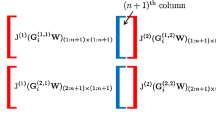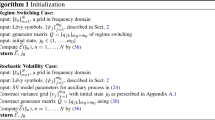Abstract
This article considers the valuation of digital, barrier, and lookback options in a Markovian, regime-switching, Black–Scholes model. In Fourier space, integral representations for the option prices are derived via the theory on matrix Wiener–Hopf factorizations. Our main focus is on the 2-state case where the matrix Wiener–Hopf factorization is available analytically. A comparison to several numerical alternatives (analytical approximations, the Brownian bridge algorithm and a finite element scheme) demonstrates that the pricing formulas are easy to implement and lead to accurate price estimates.
Similar content being viewed by others
Notes
An intensity matrix has negative diagonal and non-negative off-diagonal entries. Each row sums up to zero.
Note that in the single barrier case there might be a positive probability that the barrier is never hit. In this case, \(f_{a,\,-\infty }(t,\pi _0)\) is still a density if the probability of never hitting the barrier is attributed to \(t=\infty \).
We denote by \(\mathcal {Q}_M\) the class of irreducible \(M\times M\) generator matrices (non-negative off-diagonal entries and non-positive row sums).
This contains the implicit assumption that the eigenvectors \(v_i\) form a basis, an assumption that turned out to be sufficient in practical applications [see, e.g., Rogers and Shi (1994)]. It is possible to construct artificial examples where such a basis does not exist. The following steps of Algorithm 1 can then be modified using a basis of Jordan vectors.
In the Black–Scholes model with volatility \(\sigma \), option prices for digital and lookback options are given by [see, for e.g., Reiner and Rubinstein (1991)]
$$\begin{aligned} \overline{\mathcal {D}}(S_0,T,\varvec{\pi }_{\varvec{0}})&= \Phi \Bigg ( \frac{\ln (B/S_0) - \big (r-\sigma ^2/2\big )T}{\sigma \sqrt{T}} \Bigg ) - e^{ \big (\frac{2r}{\sigma ^2}-1\big )\ln (S_0/K)}\, \Phi \Bigg ( \frac{\ln (B/S_0) + \big (r-\sigma ^2/2\big )T}{\sigma \sqrt{T}} \Bigg ),\\ \overline{\mathcal {L}}(S_0,T,\varvec{\pi }_{\varvec{0}})&= S_0\,e^{-rt} \Big ( 1 - \frac{\sigma ^2}{2r} \Big )\, \Phi \Bigg ( \frac{\big (-r+\sigma ^2/2\big )T}{\sigma \sqrt{T}} \Bigg ) + S_0 \Big ( 1 + \frac{\sigma ^2}{2r} \Big )\, \Phi \Bigg ( \frac{\big (-r-\sigma ^2/2\big )T}{\sigma \sqrt{T}} \Bigg ), \end{aligned}$$where \(B:=\exp (b)\).
References
Abramowitz, M., & Stegun, I. A. (1965). Handbook of Mathematical Functions. New York: Dover Publications Inc.
Ang, A., & Bekaert, G. (2002). Regime switches in interest rates. Journal of Business & Economic Statistics, 20(2), 163–182.
Asmussen, S. (1995). Stationary distributions for fluid flow models with or without Brownian noise. Communications in Statistics. Stochastic models, 11(1), 21–49.
Barlow, M. T., Rogers, L. C. G., & Williams, D. (1990). Wiener–Hopf factorization for matrices. Lecture Notes in Mathematics, 784, 324–331.
Black, F., & Scholes, M. (1973). The pricing of options and corporate liabilities. The Journal of Political Economy, 81(3), 637–654.
Boyarchenko, S., & Levendorskiĭ, S. (1998). On rational pricing of derivative securities for a family of non-Gaussian processes. Institut für Mathematik, Universität Potsdam. http://opus.kobv.de/ubp/volltexte/2008/2519/.
Boyarchenko, S., & Levendorskiĭ, S. (2008). Exit problems in regime-switching models. Journal of Mathematical Economics, 44, 180–206.
Boyle, P., & Draviam, T. (2007). Pricing exotic options under regime switching. Insurance: Mathematics and Economics, 40, 267–282.
Buffington, J., & Elliott, R. J. (2002). American options with regime switching. International Journal of Theoretical and Applied Finance, 5, 497–514.
Carr, P., & Madan, D. B. (1999). Option valuation using the fast Fourier transform. Journal of Computational Finance, 2, 61–73.
Chan, L., & Zhu, S.-P. (2015). An explicit analytic formula for pricing barrier options with regime switching. Mathematics and Financial Economics, 9(1), 29–37.
Chen, S.-S. (2009). Predicting the bear stock market: Macroeconomic variables as leading indicators. Journal of Banking & Finance, 33, 211–223.
Choi, S. (2009). Regime-switching univariate diffusion models of the short-term interest rate. Studies in Nonlinear Dynamics & Econometrics, 13, 1–41.
De Olivera, F., & Mordecki, E. (2016). Computing Greeks for Lévy models: The Fourier transform approach. In A. Pinto, E. Accinelli Gamba, A. Yannacopoulos, & C. Hervés-Beloso (Eds.), Trends in Mathematical Economics (pp. 99–121). Springer International Publishing.
Elliott, R. J., Chan, L., & Siu, T. K. (2005). Option pricing and Esscher transform under regime switching. Annals of Finance, 1(4), 423–432.
Elliott, R. J., Siu, T. K., & Chan, L. (2014). On pricing barrier options with regime switching. Journal of Computational and Applied Mathematics, 256, 196–210.
Eloe, P., Liu, R. H., & Sun, J. Y. (2009). Double barrier option under regime-switching exponential mean-reverting process. International Journal of Computer Mathematics, 86(6), 964–981.
Erlwein, C., & Mamon, R. (2009). An online estimation scheme for a Hull–White model with HMM-driven parameters. Statistical Methods and Applications, 18(1), 87–107.
Escobar, M., Hieber, P., & Scherer, M. (2014). Efficiently pricing barrier derivatives in stochastic volatility models. Review of Derivatives Research, 17(2), 191–216.
Guo, X. (2001a). When the “Bull” meets the “Bear”—A first passage time problem for a hidden Markov process. Methodology and Computing in Applied Probability, 3(2), 135–143.
Guo, X. (2001b). An explicit solution to an optimal stopping problem with regime switching. Journal of Applied Probability, 38, 464–481.
Hamilton, J. D. (1989). A new approach to the economic analysis of nonstationary time series and the business cycle. Econometrica, 57(2), 357–384.
Hardy, M. R. (2001). A regime-switching model of long-term stock returns. North American Actuarial Journal, 3, 185–211.
Henry, O.-T. (2009). Regime switching in the relationship between equity returns and short-term interest rates in the UK. Journal of Banking and Finance, 33, 406–416.
Hieber, P. (2014a). First-passage times of regime switching models. Statistics & Probability Letters, 92, 148–157.
Hieber, P. (2014b). A correction note on: When the “Bull” meets the “Bear”—A first passage time problem for a hidden Markov process. Methodology and Computing in Applied Probability, 16(3), 771–776.
Hieber, P., & Scherer, M. (2010). Efficiently pricing barrier options in a Markov-switching framework. Journal of Computational and Applied Mathematics, 235, 679–685.
Jiang, Z., & Pistorius, M. R. (2008). On perpetual American put valuation and first-passage in a regime-switching model with jumps. Finance and Stochastics, 12(3), 331–355.
Kennedy, J., & Williams, D. (1990). Probabilistic factorization of a quadratic matrix polynomial. Mathematical Proceedings of the Cambridge Philosophical Society, 107, 591–600.
Kim, M. A., Jang, B.-G., & Lee, H.-S. (2008). A first-passage-time model under regime-switching market environment. Journal of Banking & Finance, 32, 2617–2627.
Kudryavtsev, O., & Levendorskiĭ, S. (2012). Fast and accurate pricing of barrier options under Lévy processes. Finance and Stochastics, 13(4), 531–562.
Lo, C. F., Lee, H. C., & Hui, C. H. (2003). A simple approach for pricing barrier options with time-dependent parameters. Quantitative Finance, 3, 98–107.
London, R. R., McKean, H. P., Rogers, L. C. G., & Williams, D. (1982). A martingale approach to some Wiener–Hopf problems. Lecture Notes in Mathematics, 920, 68–90.
Metwally, S., & Atiya, A. (2002). Using Brownian bridge for fast simulation of jump-diffusion processes and barrier options. Journal of Derivatives, 10, 43–54.
Mijatović, A., & Pistorius, M. (2013). Continuously monitored barrier options under Markov process. Mathematical Finance, 23(1), 1–38.
Naik, V. (1993). Option valuation and hedging strategies with jumps in the volatility of asset returns. Journal of Finance, 48(5), 1969–1984.
Raible, S. (2000). Lévy processes in finance: Theory, numerics, and empirical facts. PhD thesis, Freiburg University.
Reiner, E., & Rubinstein, M. (1991). Breaking down the barriers. Risk, 4(8), 28–35.
Rogers, L. C. G. (1994). Fluid models in queueing theory and Wiener–Hopf factorization of Markov chains. Annals of Applied Probability, 4(2), 390–413.
Rogers, L. C. G., & Shi, Z. (1994). Computing the invariant law of a fluid model. Journal of Applied Probability, 31(4), 885–896.
Acknowledgements
I want to thank the editor and the anonymous referees for valuable comments that helped to improve earlier versions of this article.
Author information
Authors and Affiliations
Corresponding author
Additional information
This research was carried out while Peter Hieber was a research assistant at TU Munich.
Rights and permissions
About this article
Cite this article
Hieber, P. Pricing exotic options in a regime switching economy: a Fourier transform method. Rev Deriv Res 21, 231–252 (2018). https://doi.org/10.1007/s11147-017-9139-1
Published:
Issue Date:
DOI: https://doi.org/10.1007/s11147-017-9139-1




